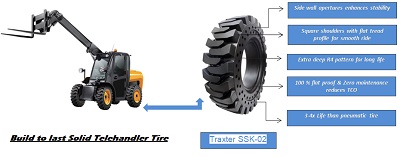
Tire maker Trident International has shared tips to help people who buy tires for telehandlers know what to look for as they shop.
Telehandlers are versatile, efficient, multifunction machines that combine the lifting capability of a forklift with the reach and elevation of a crane.
Telehandlers should be fitted with tires that offer high stability that matches the demands of their applications: lifting heavy loads and reaching high heights, often on unstable or unfinished surfaces.
Tires affect a telehandler’s reliability, ride comfort, and total cost of ownership. They also affect the rental customer’s jobsite performance.
Currently, three types of tires are available for telehandlers: pneumatic (air filled), foam-filled pneumatic, and solid. One should consider these factors when making a selection.
1. Puncture Resistance: Solid tires have a full rubber construction and offer maximal puncture resistance. They never go flat! Foam-filled pneumatic tires are puncture proof but can be damaged by metal or sharp debris. If the tire suffers a severe injury, foam can come out of the tire and cause unpredicted downtime. Pneumatic tires are not puncture proof.
2. Damage Resistance: Solids tires are highly resistant to cuts and impact damage. They should be considered in applications where the underfoot conditions are harsh. Foam-filled tires have a similar resistance to cuts and chunking as pneumatic tires

3. Service Life: Solid tires have a deeper wear-resistant tread and typically last 3-4 times longer than equivalent pneumatic or foam-filled tires.
4. Stability and Overall Comfort: While both foam-filled and solid tires offer very good stability, solids deform less under loads. This can be an advantage given the purpose of telehandlers. Sidewall apertures in solid tires help absorb shocks. Apertures also help dissipate heat more effectively, thus making solid tires suitable for continuous operations. Trident has developed new non-directional tread pattern with a continuous centre lug and higher lug-to- void ratio that reduces wear vibration.

5. Total Cost of Ownership (TCO): Although solid tires generally cost more to buy, they reduce operating cost during life of the telehandler. It’s important for tire buyers to look at the total cost of ownership, including serviceability and the potential cost of downtime, not just the acquisition cost.

Given that solids never go flat and resist damage better than other types of tires, they offer an opportunity to reduce overall tire cost, thus contributing to high productivity and profitability in all operating conditions.
They also offer a more predictable lifecycle over pneumatic and foam-filled tires, which is great for rental equipment, as most of the time the telehandler owner is not unaware of exactly how the customer is using the machine.